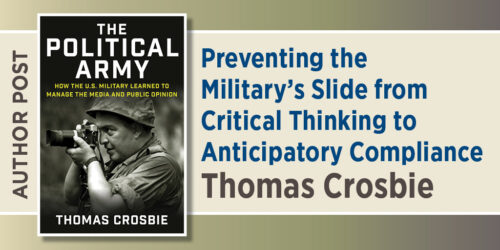Aaron Belkin on Military Masculinity
“Americans have been encouraged to understand military masculinity as an archetypal expression of democracy. But there is something profoundly undemocratic about military masculinity and the way in which public adulation of it is premised on a disavowal of its blemishes.”—Aaron Belkin
We continue our week-long focus on Bring Me Men: Military Masculinity and the Benign Façade of American Empire, 1898-2001, by Aaron Belkin with an excerpt from the introduction. You can read the full introduction here and you can also win a free copy of Bring Me Men:
Military masculinity is not what it seems to be
Professor George Brown, who has studied and counseled transgender veterans for more than two decades at the Johnson City, Tennessee, Veterans Administration hospital, has found that some pre-operative male-to-female (MTF) transgender service members in the U.S. armed forces have volunteered for dangerous missions to prove their masculinity. Brown says that prior to reaching a stage of acceptance, transgender persons often seek to prove to themselves that they are not transgender, a phenomenon he refers to as the “flight from transgender.” Pre-operative MTF transgender veterans told him that during the Vietnam War, they sought to demonstrate the correctness of their given, biological sex by affirming their masculinity beyond doubt. To do so, they volunteered as “tunnel rats” who infiltrated underground enemy complexes, pistol in hand, to kill as many Vietnamese as possible. They believed that if they lived, they would prove their masculinity, which in turn would confirm their biological status as men and hence not transgender, and that they would not need to go through the painful and stigmatized sex transition from man to woman. And if they died, that would be an acceptable price to pay for achieving the status of a real man. Brown told a journalist that “They’re so uncomfortable with who they are that they’d rather have it beaten out of them or die
trying….”
While many troops believe that service in the armed forces proves their masculine status, they are not the only Americans who have perceived a powerful connection between masculinity and the military. When George Bush famously landed on the flight deck of the aircraft carrier USS Abraham Lincoln in 2003 and then emerged from the cockpit wearing military gear, he was following a long line of politicians who have used visual and other maneuvers to demonstrate their masculinity in a militarized context—sometimes successfully, sometimes not. Former Democratic presidential nominee John Kerry stepped onto the stage in Boston to receive his party’s nomination in 2004 and began by saluting as he declared, “I’m John Kerry and I’m reporting for duty.” Hopeful that their candidate could, unlike Al Gore, muster sufficient masculine credibility to prevail at the ballot box, the audience erupted en masse. During the 1988 presidential campaign, Michael Dukakis was ridiculed widely for riding in a tank. The problem was not that he sought to prove his masculinity in a military context, but that his effort to do so was unpersuasive. His body seemed tiny in comparison to the larger-than-life tank; his facial expression suggested that he was not in control of the armored machine beneath him; and his pressed shirt and tie were visible under his uniform. The failed demonstration of masculinity sustained a perception of Dukakis as incompetent and exposed the artifice of military masculinity as something that could be appropriated with a more compelling performance.
The staging of a photo opportunity may seem trivial, but warrior identities can be so closely aligned with ideas about masculinity that some American presidents have been motivated to wage war to demonstrate their masculinity. Presidents may believe that wearing military gear, addressing graduates of service academies, visiting troops at the front, saluting Marines who guard the presidential helicopter and other emulations of masculinity in military contexts convey the message that they are competent and able leaders. At the same time, and without reducing motives for war to a single factor, presidents have realized that wielding military power effectively can enhance a masculine reputation, while military defeat can invite critiques of their masculinity. Hence when President McKinley opted initially for a diplomatic response to news of Spain’s sinking of the USS Maine in 1898, the Atlanta Constitution wrote that, “At this moment there is a great need of a man in the White House.” When Woodrow Wilson declined at first to involve the U.S. in World War I, former President Theodore Roosevelt said that he had “done more to emasculate American manhood… than anyone else I can think of.” Historians, psychologists and political scientists have argued that in one form or another, all modern American presidents have understood decisions to use force through a gendered lens. Lyndon Johnson claimed that after the bombing of North Vietnam, “I didn’t just screw Ho Chi Minh. I cut his pecker off.” Presidents and presidential candidates often appear to believe that they cannot win elections
or govern effectively unless they can show that they are masculine by waging war successfully.
Later in the chapter, Belkin writes:
Americans have been encouraged to understand military masculinity as an archetypal expression of democracy. But there is something profoundly undemocratic about military masculinity and the way in which public adulation of it is premised on a disavowal of its blemishes. As I argue throughout this book, willful ignorance about military masculinity’s abject underside is not just a metaphor for the suppression of American empire’s nastiest warts, but is implicated in that suppression. Thus, the undemocratic aspect of military masculinity is not just the soldier’s propensity to obey uncritically, but the broader system of civilian and military disavowals that enable and reflect that inclination, thus sustaining simplistic ideas about American empire.
A new masculine paradigm
My narrative begins approximately a century ago, when American military masculinity consolidated as a dominant paradigm for male authority, a para digm that came to model normative citizenship for civilians, not just soldiers, and that valorized toughness on the one hand, and obedience and conformity on the other. Americans have glorified warriors since the earliest days of the republic, and late-eighteenth-century treatises on the revolutionary war lionized George Washington’s martial heroism as a critical determinant of the British defeat. Civil War veterans served as U.S. presidents for a generation, and “The epitome of honor and the model of manly character in the post-Civil War period was the veteran.” While reverence for American warriors is a longstanding tradition, military masculinity did not emerge as a dominant paradigm until the end of the nineteenth century, when imperialists advocated American involvement in the 1898 war against Spain as an opportunity to remedy the nation’s feminization. That war marked a turning point in how soldiers and soldiering were represented in popular culture such as literature for juvenile audiences. Before the turn of the twentieth century, magazines and books written for juvenile audiences did not epitomize soldiering as the most privileged demonstration of masculinity. After the Spanish-American War, however, the literature changed, as authors began representing soldiering as paradigmatic of what it meant to be a real man.
1 Response
Leave a Reply
You must be logged in to post a comment.




Great post, Everyone will have the same idea.